Utility Reliability Problems
To gain a broader understanding of power system reliability, it is necessary to understand the root causes of system faults and system failures.
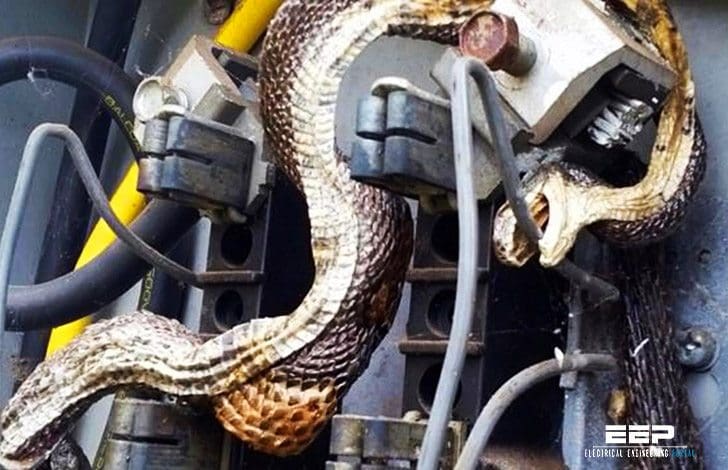
A description of major failure modes is provided below.
- Underground Cable
- Transformer Failures
- Lightning
- Tree Contact
- Birds
- Squirrels
- Snakes
- Insects
- Bears, Bison, and Cattle
- Mice, Rats, and Gophers
- Vandalism
1. Underground Cable
A major reliability concern pertaining to underground cables is electrochemical treeing. Treeing occurs when moisture penetration in the presence of an electric field reduces the dielectric strength of cable insulation. When the dielectric strength is degraded sufficiently, transients caused by lightning or switching can result in dielectric breakdown.
Electrochemical treeing usually affects extruded dielectric cable such as cross-linked polyethylene (XLPE) and ethylene-propylene rubber (EPR), and is largely attributed to insulation impurities and bad manufacturing.
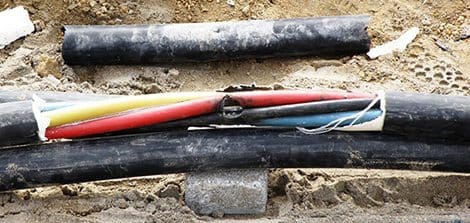
To reduce failures related to electrochemical treeing, a utility can install surge protection on riser poles (transitions from overhead to underground), can purchase tree-retardant cable, and can test cable reels before accepting them from the manufacturer.
Existing cable can be tested and replaced if problems are found. One way to do this is to apply a DC voltage withstand test (approximately 3 times nominal RMS voltage). Since cables will either pass or not pass this test, information about the state of cable deterioration cannot be determined.
Another popular method for cable testing is to inject a small signal into one end and check for reflections that will occur at partial discharge points. Other methods are measuring the power factor over a range of frequencies (dielectric spectroscopy), analyzing physical insulation samples in a lab for polymeric breakdown (degree of polymerization), and using cable indentors to test the hardness of the insulation.
Tracing an Underground Cable Fault (VIDEO)
Cant see this video? Click here to watch it on Youtube.
Not all underground cable system failures are due to cable insulation. A substantial percentage occurs at splices, terminations, and joints. Major causes are due to water ingress and poor workmanship. Heat shrink covers can be used to waterproof these junctions and improve reliability.
The last major reliability concern for underground cable is dig-ins. This is when excavation equipment cuts through one or more cables. To prevent dig-ins, utilities should encourage the public to have cable routes identified before initiating site excavation. In extreme cases where high reliability is required, utilities can place cable in concrete-encased duct banks.
2. Transformer Failures
Transformers are critical links in power systems, and can take a long time to replace if they fail. Through faults cause extreme physical stress on transformer windings, and are the major cause of transformer failures.
Overloads rarely result in transformer failures, but do cause thermal aging of winding insulation.
When a transformer becomes hot, the insulation on the windings slowly breaks down and becomes brittle over time. The rate of thermal breakdown approximately doubles for every 10°C. 10°C is referred to as the “Montsinger Factor” and is a rule of thumb describing the Arrhenius theory of electrolytic dissociation.
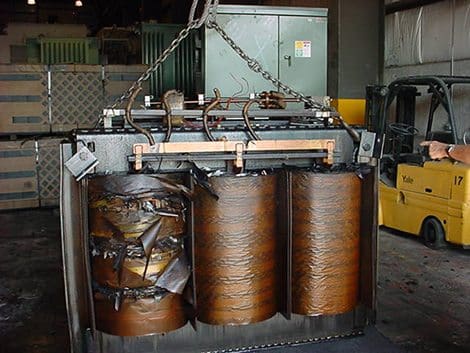

Because of this exponential relationship, transformer overloads can result in rapid transformer aging. When thermal aging has caused insulation to become sufficiently brittle, the next fault current that passes through the transformer will mechanically shake the windings, a crack will form in the insulation, and an internal transformer fault will result.
Extreme hot-spot temperatures in liquid-filled transformers can also result in failure.
This is because the hot spot can cause free bubbles that reduce the dielectric strength of the liquid. Even if free bubbles are not formed, high temperatures will increase internal tank pressure and may result in overflow or tank rupture.
Failure of 230/69kV Autotransformer (VIDEO)
Cant see this video? Click here to watch it on Youtube.
Many transformers are fitted with load tap changers (LTCs) for voltage regulation. These mechanically moving devices have historically been prone to failure and can substantially reduce the reliability of a transformer.
Manufacturers have addressed this problem and new LTC models using vacuum technology have succeeded in reducing failure rates.
3. Lightning
A lightning strike occurs when the voltage generated between a cloud and the ground exceeds the dielectric strength of the air. This results in a massive current stroke that usually exceeds 30,000 amps. To make matters worse, most strokes consist of multiple discharges within a fraction of a second. Lightning is the major reliability concern for utilities located in high keraunic areas.
An isokeraunic map for the world is shown in Figure 1 below.
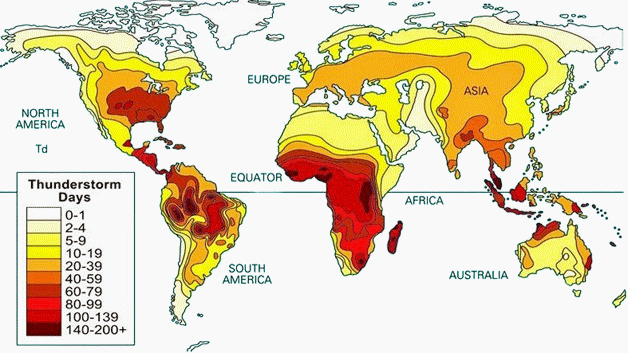

Lightning can affect power systems through direct strikes (the stroke contacts the power system) or through indirect strikes (the stroke contacts something in close proximity and induces a traveling voltage wave on the power system).
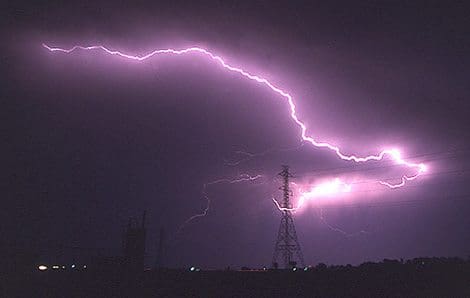

Lightning can be protected against by:
- Having a high system BIL,
- Using shield wires,
- Using surge arrestors to clamp voltages across equipment, and
- Having a low impedance ground.
Direct strikes are virtually impossible to protect against on a distribution system.
4. Tree Contact
Trees continuously grow, can fall over onto conductors, can drop branches onto conductors, can push conductors together, and can serve as gateway for animals. This is why many utilities spend more on tree trimming than on any other preventative maintenance activity.
This is because a moist tree branch has a substantial resistance. A small current begins to flow and starts to dry out the wood fibers. After several minutes, the cellulose will carbonize, resistance will be greatly reduced, and a short circuit will occur. Branches brushing against a single phase conductor typically do not result in system faults.
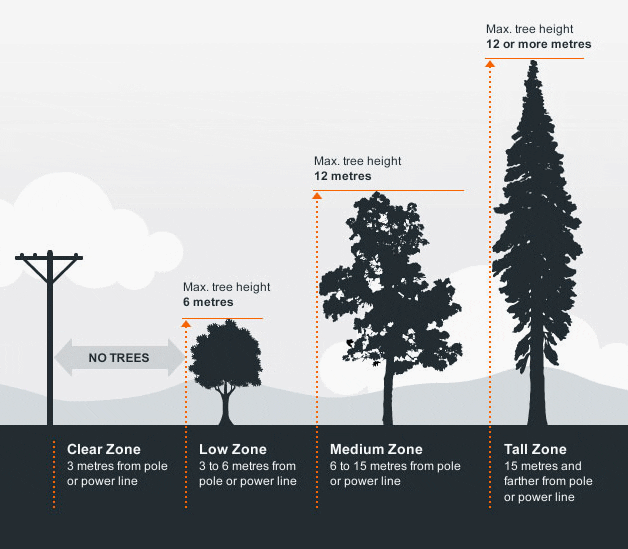

Faults due to tree contact can be reduced by using tree wire. This is overhead wire with an insulated jacket similar to cable. Tree wire can be effective, but faults tend to result in conductor burndown since they will not motor (move themselves along the conductor) like faults on bare conductor.
5. Birds
Birds are the most common cause of animal faults on both transmission systems and air insulated substations. Different types of birds cause different types of problems, but they can generally be classified as nesting birds, roosting birds, raptors, and woodpeckers.
Nesting birds also attract predators such as raccoons, snakes, and cats. These predators can be a worse reliability problem than the birds themselves.
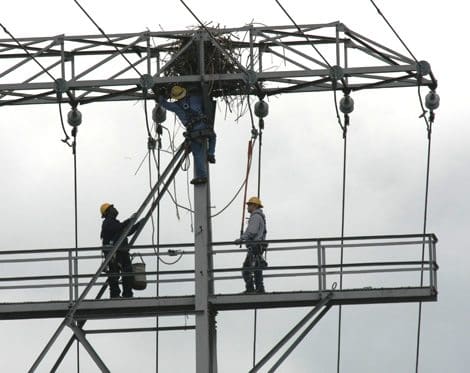

Roosting birds use electrical equipment to rest on or to search for prey. They can be electrocuted by bridging conductors with their wings, and their excrement can contaminate insulators. To prevent birds from roosting, anti-roosting devices can be placed on attractive sites. For locations that cater to thousands of roosting birds, more extreme deterrent methods such as pyrotechnics can be used.
Raptors are birds of prey such as eagles, hawks, ospreys, owls, and vultures. Reliability problems are similar to other roosting and nesting birds, but special consideration may be required since most raptors are protected by the federal government.
Woodpeckers peck holes in wood with their beaks as they search for insects. This does not harm trees (the bark regenerates), but can cause devastating damage to utility poles. This can be prevented by using steel poles, by using repellent, or by tricking a woodpecker into believing that there is already a resident woodpecker (woodpeckers are quite territorial).
6. Squirrels
Squirrels are a reliability concern for all overhead distribution systems near wooded areas. Squirrels will not typically climb utility poles, but will leap onto them from nearby trees.
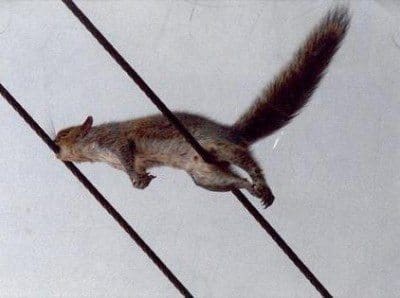

They cause faults by bridging grounded equipment with phase conductors. Squirrel problems can be mitigated by cutting down nearby access trees or by installing animal guards on insulators.
7. Snakes
Snakes are major reliability concerns in both substations and underground systems. They can squeeze through very small openings, can climb almost anything, and have the length to easily span phase conductors.
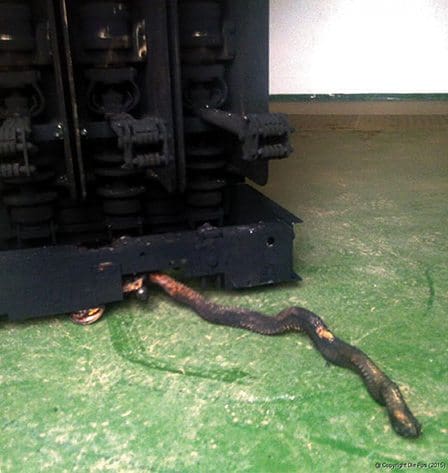

Snakes are usually searching for food (birds in substations and mice in underground systems), and removing the food supply can often remove the snake problem. Special “snake fences” are also available.
8. Insects
It is becoming more common for fire ants to build nests in pad mounted equipment.
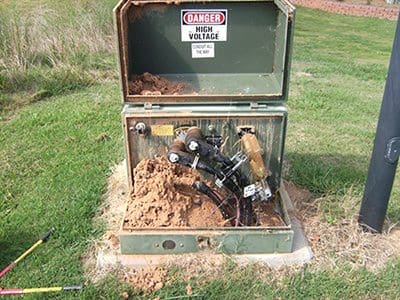

Their nesting materials can cause short circuits, the ants can eat away at conductor insulation, and they make equipment maintenance a challenge.
9. Bears, Bison, and Cattle
These large animals do not typically cause short circuits, but degrade the structural integrity of poles by rubbing on guy wires. Bears can also destroy wooden poles by using them as scratching posts, and black bears can climb wooden utility poles. These problems can be addressed by placing fences around poles and guy wire anchors.
10. Mice, Rats, and Gophers
These rodents cause faults by gnawing through the insulation of underground cable. They are the most common cause of animal-related outages on underground equipment. To make matters worse, they will attract snakes (also a reliability problem).
11. Vandalism
Vandalism can take many different forms, from people shooting insulators with rifles to professional thieves stealing conductor wire for scrap metal. Addressing these reliability problems will vary greatly from situation to situation.
Reference: The electric power engineering handbook – L.L. Grigsby (Purchase hardcover book from Amazon)





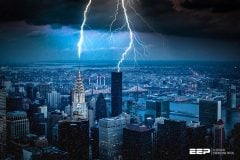

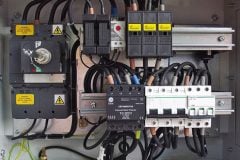
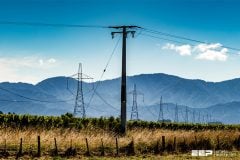


Human intervention or error.
To create chaos in an area for social or political reasons, it is possible that some people may collude with personnel to intentionally sabotage a protection system.
Bad weather is another major cause of power protection system failure. In the event that a storm should happen, it is likely for the protection system to be disrupted and hence power failure or outage.
Very nice and helpful information has been given in this article. Appreciate all your efforts that you have put in this.
Hi Edvard and beloved Electrical engineers,
It was nice to read your technical posts. Appreciate your efforts…
Electricity is great power, Our future also… Everything needs electricity, our power requirement go on hike infinite…
One of the present issue which is going to be the future problem is “Trees”, wait… It is viewed that Trees are against electricity, but actually I would say the “Electricity is against the Trees” (Telling it from my heart).
Yes you got the point, i.e. between Environment vs Electrical energy!!! Lives vs Business…
Think beyond infinite limit once, “Can we live without electricity or Trees” ???
So, Can engineering the electricity without damaging any single tree, that would be all of ours (Earth) success. (I am ready to spare my life for it).
May be our method of present engineering (generating, transmitting, applying) the electricity is not correct… There may be another way of engineering the electricity without damaging Environment?
Is it Science stopped with the initial innovation?
I haven’t just writtten, It has come from aspiration…
because I, you and we all will pass way on one day but the world life should stay forever. It is only possible with either Environment or Unharmed electricity!!!
The articles are very instructive
We are facing problem in rainy season. If supply fails from local electric company in rainy season for more than 15 Min. indoor control panel gets wet causing tripping of breaker.We have to open panel & dry it then the breaker stands. The panel is water proof. How the moisture enters into panel ? Is it due to damage of only plastic coating ? The meager test for cable are OK & does not reveal any information.
If anybody came across such problem what was solution for the same.
There other major causes for failures:
• Design errors and deficient or errors of equipments and materials specification.
• Incorrect manufacturing process and procedures and use of not suitable materials.
• Improper package, handling and transportation.
• Inappropriate storage.
• Incorrect mounting of equipments and materials.
• Factory Acceptance Tests (FAT) and Site Acceptance Tests (SAT) not performed or not performed in accordance with applicable standards and not witnessed by the Owner representative.
• Improper use of equipments.
• Improper or lack of maintenance.
Dear All.
Its been realy a nice experience to read about various electrical issues and comments.
Basically I can be treated as a new entry in the Electrical Engineering and I find this forum as a learning Hub for me.
I am experiencing a problem in my Transmission and Grids Network.
The T/Lines interconnecting about 6 NO different Wind Power Projects totalling to 300 MW Generation and situated under the coastal effect influence and barren land. The area is less cultivated. The problemetic geographical area is 50% dominated by the dry land and 50 % by the salinity hit land with very less cultivation.
Now during Fog , The tripping of one T/Line initiates some times the tripping of more than 5 transmision lines coincidently.
I am of the openion that no doubt it could be a matter of insulator cleaning but it is also a matter of nongraded Protection and transients supported with the re striking voltages during the process of cascaded trippings.
However as I told that I m a new entry so please do guide and educate that how to avoid such large No of coincident outages of the T/Lines , which normally plunges the entire area in Dark.
I Love to be student of you ALL.
Jawaid
I really like the articles but up by EEP, very helpful and Hardly any errors.
Thank You
Small correction with a big impact. Water trees ( the new term for the old electro- chemical trees) are stress enhancements that can initiate electrical trees. This process can take decades. Electrical trees grow when during transient overvoltage events until the inception voltage is sufficiently low enough for partial discharge activity to be present at the operating voltage. This process can take years. Once the erosion is constant at operating voltage the erosion process is accelerated the the insulation will most likely fail soon.
This is a good write up but can fault be eliminated in our power system how can we achieved 365 days uninterrupted supply.
Ideal system not physically possible but with having redundancy we can have very high up-time, the very concept used in Data centers
Good article. Thanks.
This is a very good article, thank you for your good publications
Thank for all your effort on supplying all electrical specially for those who work on sites
so plz accept my thanks
Good article .It covers almost all aspects with good visuals. Thanks.